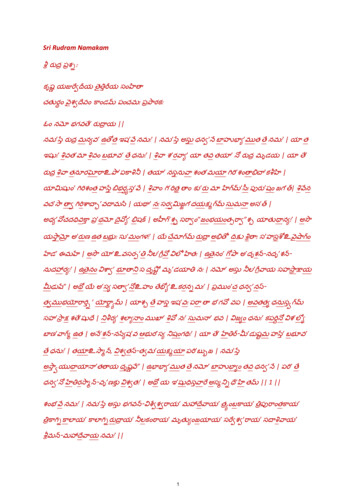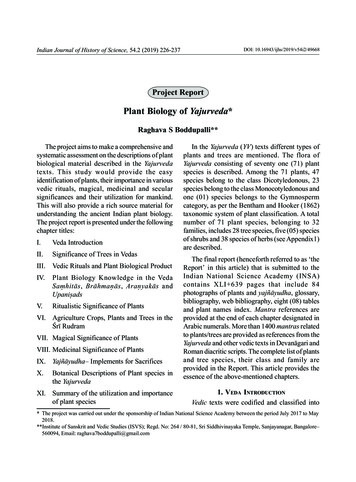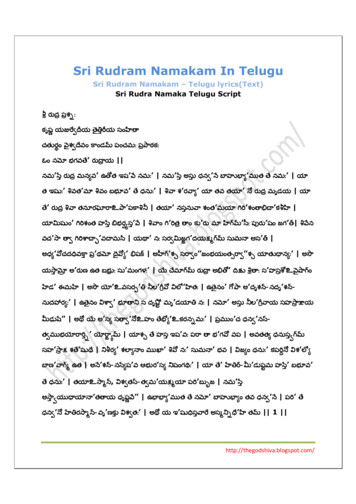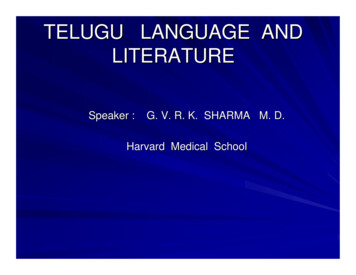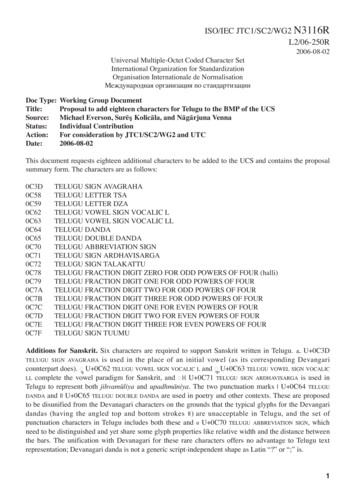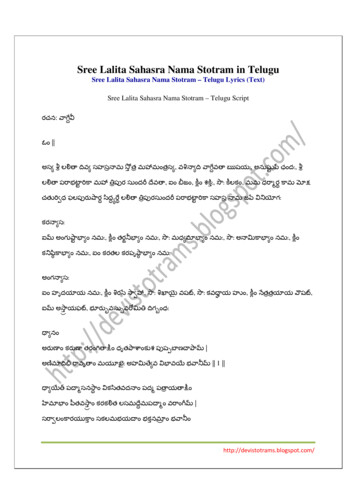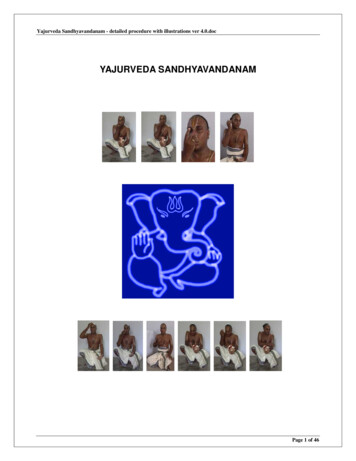
Transcription
Yajurveda Sandhyavandanam - detailed procedure with illustrations ver 4.0.docYAJURVEDA SANDHYAVANDANAMPage 1 of 46
Yajurveda Sandhyavandanam - detailed procedure with illustrations ver 4.0.docTable of ContentsYAJURVEDA SANDHYAVANDANAM . 1Foreword. 4Scriptural Authority (Pramanam) . 5Meaning and Philosophical significance . 6Format and Anatomy . 7Who Can Perform . 7When To Perform . 8Things You Need . 9Exceptions. 9Manasika Snanam and Mantra Snanam. 9Recitation of Mantras. 10Science, Electricity and Health. 11SANDHYAVANDANAM STEPS IN DETAIL. 13Section I – POORVAANGAM (also called ‘Sandhyavandanam’) . 131. Achamanam (Anatomy Cleansing – external body). 132. Ganapati Dhyanam . 143. PrAnAyamaha (Anatomy Cleansing – internal body). 154. Sankalpah (Statement of purpose / resolve) . 164.a. Satvika Tyaga – optional – for Sri Vaishnavas only (Surrender and dedication). 175. Prokshanam (‘sprinkling’) or Marjanam (External/Physical Purification). 186. Prashanam (‘Sipping’ – for Internal/Mental Purification). 207. PunarProkshanam / PunarMarjanam (sprinkling / purification again) . 218. Arghyam (Offering to Sun: bring light / eliminate darkness). 238.a. PrAnAyamah (Anatomy Cleansing – internal body). 23Page 2 of 46
Yajurveda Sandhyavandanam - detailed procedure with illustrations ver 4.0.doc8.b. Arghyam (Offering to Sun: bring light / eliminate darkness). 248.c. Prayashchittha PrAnAyamah (Anatomy Cleansing – external body). 258.d. Prayaschitta Arghyam (Apology for any delay) . 269. SandhyOpAsanam . 2710. Adityaadi Tarpanam / Keshavadi Tarpanam (Thanks for benefits received). 28Section II – UTTARAANGAM (also called ‘Gayathri Japam’). 291. Achamanam (Anatomy Cleansing – external body). 292. Ganapati Dhyanam . 303. PrAnAyamaha (Anatomy Cleansing – internal body). 304. Sankalpah (Statement of purpose / resolve) . 325. Gayatri Japam . 325.a.PrAnAyam mantra Nyasa (Preparation for gayatri) . 325.b.Pranayamah (Anatomy Cleansing – internal body). 345.c.Gayatri Avahanam (Invoking Goddess Gayatri) . 355.d.Gayatri Japam (Meditating on Gayatri) . 365.e.Gayathri Upastanam (Realization of the the presence of the Lord) . 385.f.Surya Upastanam (Worship to the Sun) . 396. Samashti Abhivadanam: Sandhyadi devata vandanam (Salutations to the Sandya Gods). 417. Samashti Abhivadanam: AbhivAdanam (Expression of one's lineage) . 428. Samashti Abhivadanam: DikDevataa Vandanam (Salutations to the directional gods). 439. Achamanam (Anatomy Cleansing – external body). 449.a. Satvika Tyaga – optional – for Sri Vaishnavas only (Surrender and Dedication). 4510. SriRanga Mangala Manim – optional – Remembering archa murthys . 46Page 3 of 46
Yajurveda Sandhyavandanam - detailed procedure with illustrations ver 4.0.docForewordThere are many resources on Yajurveda Sandhyavandanam available on the internet. While each ofthem has something special that adds to an adhyaayi’s understanding, how wonderful would it be ifthe essence of all of them was condensed into one single resource? That was the thought behind thisdocument’s origin.This document was originally intended as a ‘rough book’ to compile all the relevant theory andpractice on the Yajurveda Sandhyavandanam in one concise resource, which the adhyaayi could usefor his own study and practice.Over a year’s time, this book developed into an invaluable reference that contained everything fromthe scriptural sanctions for the Sandhyavandanam, to the correct Vedic ‘ucchaaranai’ of variousmantras recited during the Sandhyavandanam procedure.The adhyaayi has continued to update this document as his own understanding of the deep meaningand importance of the Sandhyavandanam anushtanam has improved. This process will continue.For now, the adhyaayi offers unto the lotus feet of the Lord, version 4.0 of this book containingmany updates and corrections from the previous version.The adhyaayi sincerely apologises for any mistakes that may be found in the document. Please emaildetails of errors of omission or commission to kausybaby@yahoo.com for correction in the nextedition.Kaayena Vaacha, Manasa, Indriyaihi Va, Budhyaathmana Va, Prakruthe Swabhava,Karomi Yadyat Sakalam Parasmai Naaraayanaaya Iti Samarpayaami.Adhyaayi: Kaustubha ChakravarthyBangalore, 25th March 2010Page 4 of 46
Yajurveda Sandhyavandanam - detailed procedure with illustrations ver 4.0.docScriptural Authority (Pramanam)There are references in the vedas regarding Sandyavandanam. A reference occurs in "Second prasna,Second Anuvaka of Thaithria Aranyaka (Yajur Veda)", explaining procedure of worship. Theprocedure of worship indicated is by offering "Arghya" (water in the palms of both hands thrownup), at the time of sunrise and sunset, meditating on Aditya (Sun).Ishvashya upanishad of Shukla Yajurveda also refers to Sun worship as above at sunrise and sunset.Chandogya upanisad (Chapter 2 Section 6) discusses "Aditya vidya" explaining the importance ofmeditation of Sun or Aditya at sunrise and sunset, bringing out also the points mentioned above.Chapter 3, Section 12 of this upanishad explains meditation of aditya through gayatri. It alsoexplains that the sun in the horizon outside and the sun element inside us are one and the same andthere is no difference. The identity should be kept in mind while meditating through gayatri. This isthe meaning of "Asavadityao brahma" recited during Sandyavandanam.These views are also echoed in Aditya Hridaya of the Yuddakanda of Ramayan. Agasthya explainsto Sri Rama, the merits of worshipping Aditya. Aditya protects everyone, helps them in their duties,gives lustre, removes ignorance and provides happiness. He is friend of water and resides in everyliving thing.All Vedic religions have given great importance to Sandyavandanam. It is said that one who doesnot perform Sandyavandanam is ever impure and is thus rendered unfit to perform the Vedic rites the nitya (daily) or naimithica (occasional) duties prescribed in the scriptures. If however he didperform the duties once in a way in spite of self inflicted impurity (due to non performance ofSandyavandanam regularly) the said performance will not yield any result. This point has also beenbrought out by Poigai alwar (Mudal Tiruvandadi stanza 3).Some additional observations maybe viewed atSri Mani Vardarajan's /0038.htmlSri Sadagopan Iyengar's tuals/jun2002/0011.htmlPage 5 of 46
Yajurveda Sandhyavandanam - detailed procedure with illustrations ver 4.0.docMeaning and Philosophical significanceAditya represents pure sattwa characteristics and He is bright (prakasa) and light (laghu). He isentrusted with the portfolio of health of souls (chetanas) in our planet as per the distribution of dutiesduring the evolution of the universe. Our human body contains every element of the universe andthey get subdued or become invisible due to the character (Rajoguna and tamoguna) of theindividuals. However, it is possible to culture any of the elements of the universe present withinhimself by providing suitable environment. Worship through Arghyam is a process by which theelement of Aditya within us can be cultured and in turn acquire the qualities of Aditya - namelylustrous and health preserving quality of the body and mind, light body, high intellect with graspingpower, high intuition, memory and many other qualities.The arghya should be offered seeing the sun in the horizon and meditating (through gayatri) onaditya.The Arghyas delivered skyward from the palms of the worshipper serve as missiles to destroydemons known as Mandehaasuras attacking the sun. This statement in the vedas has a greatsignificance. Vedas are also refer red to as Thrayi - that is the statements have three meanings(external, internal and philosophical). The philosophical meaning of this statement is important. Theelement of sun in our body is clouded by our "Rajoguna" and "Tamoguna". The Arghyams offerredas worship to Sun or Aditya at sunrise and sunset will help free the sun element in us. The wordMandeha may also mean body (“mama deha”), therefore the word mandehaasuras refers to the evilsin our body.Page 6 of 46
Yajurveda Sandhyavandanam - detailed procedure with illustrations ver 4.0.docFormat and AnatomySection of SandyavandanamAchamanam, PranayanamPurposeAnatomy PurificationSankalpahStatement of purpose / resolveSatvika TyagaSurrender and dedicationProkshanam, Prasanam, Punah ProkshanamPurification (external – prokshanam, internal –prasanam)ArghyamOffering to Sun: bring light / eliminate darknessPranayanamPurificationPrayaschita ArghyamApology for any delayAdityaadi Tarpanam / Kesavadi TarpanamThanks for benefits receivedPranayaman Mantra JapamPreparation for GayatriGayatri AavahanamBringing in (invoking) the LordGayatri JapamMeditating on the LordPranayamamPurificationUpastanamRealization of the the presence of the LordSandyadi Devata VandanamSalutations to the Sandya godsAbhivadanamExpression of one's lineageDik Devataadi VandanamSalutations to the directional godsSriranga Mangala ManimRemembering archa murthysThe Vedic references bring out the importance of worshipping Aditya through Arghyam andmeditation through Gayatri at sunrise and sunset.Keeping the above in view, the sages of the past have given a format for the performance ofSandyavandanam (using Vedic hymns) during sunrise, midday and sunset. In Yagna prakarana,vedas also bring out the importance of 'Sudhikarana' or purification. The purification covers bothinside and outside of our body. Hence the format includes the purification process. "Prokshanam" isan external purification process, Prasanam and Pranayanam are internal purifiation processes.Who Can PerformSandyavandanam is performed by an individual after "Upanayanam". Upanayanam is a Vedic ritualprescribed for Brahmins, Khshatriyas and Vaishyas. It includes wearing of Yagnopavitham andlearning of Gayathri mantra.The upanayanam entitles one to learn and recite vedas and perform rituals.Page 7 of 46
Yajurveda Sandhyavandanam - detailed procedure with illustrations ver 4.0.docYagnopavitha is a thread going around the body from left shoulder to navel and back to left shouldervia our back. Thus it symbolises a thread going around our Antaryami or Vishnu seated in our heart.Yagnopavitha or the sacred thread is a thread with three strands, each strand containing three threads.The nine threads correspond to the nine deities installed (Prithvi, aap, tejas, vayu, ether, prana,atman, antaratman, paramatman). The installation of the deities is done as per the prescribedprocedur
Yajurveda Sandhyavandanam - detailed procedure with illustrations ver 4.0.doc Page 4 of 46 Foreword There are many resources on Yajurveda Sandhyavandanam available on the internet. While each of them has something special that adds to an adhyaayi’s understanding, how wonderful would it be if
